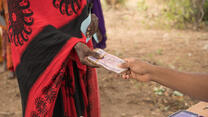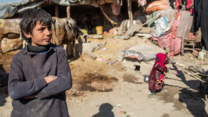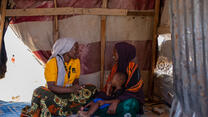This report describes the impacts of the winter cash transfer program run by UNHCR and partners from November 2013 to April 2014. The program gave $575 USD via ATM cards to 87,700 registered Syrian refugees in Lebanon with the objective of keeping people warm and dry during cold winter months.
This research measured the impacts of cash on numerous metrics of household well-being, negative coping strategies, and food and non-food consumption. It tested whether cash produces negative consequences, such as local-level inflation or the drawing of more refugees to regions with assistance (a “pull factor”). And finally, it sought to estimate the multiplier effect of cash aid. For every dollar of cash assistance, how much would the Lebanese economy benefit?
The study was based on a rigorous design that allows the Research Team to quantify the causal impacts of the winterization program. According to selection criteria of the program, households residing above 500-meters altitude were eligible for cash assistance, while those living below 500 meters were not. In order to evaluate the program’s impact, the study compared beneficiaries residing slightly above 500 meters (treatment group) to similar non-beneficiaries residing slightly below (control group). Treatment and control groups had very similar characteristics prior to the start of the program. Differences measured after the program’s implementation represent causal impacts of cash assistance.
This research design is a key contribution to research on Syrian refugees in Lebanon, and more generally to research on the impacts of cash aid in a humanitarian crisis. This is the first study, to the researchers’ knowledge, to rigorously compare refugees receiving cash to those not receiving cash, which makes it possible to quantify the causal impact of the assistance.
The research found a number of impacts from the cash assistance:
- The current value of cash assistance is too low to meet the program’s objective of allowing all beneficiaries to keep warm constantly throughout the winter and beneficiaries only partially use it for this purpose. Cash assistance for beneficiaries at high altitude during winter months increases spending on heating supplies, however, almost half of beneficiaries report that heating supplies were often not enough to keep warm. This is not because heating supplies are unavailable in the market, but because beneficiaries’ income is so low that they are forced to use the cash assistance to satisfy other basic needs, in particular food. Households spent the majority of cash assistance on food and water despite receiving food vouchers from WFP.
- The program did not have a meaningful impact on prices. Markets are able to provide sufficient quantities of the goods and services that beneficiaries demand. Across approximately 50 consumer goods the Research Team observed no meaningful trend toward higher prices in treatment communities.
- Cash assistance increases access to school and reduces child labor. The program also increases mutual support between beneficiaries and other community members, and decreases tensions within beneficiary households.
- The program has significant multiplier effects on the local economy. Each dollar that beneficiaries spend generates 2.13 dollars of GDP for the Lebanese economy.
- The vast majority of beneficiaries (more than 80 percent) prefer cash assistance compared to in-kind assistance (e.g., food parcels).
- The study found no evidence of a number of hypothesized negative consequences of cash assistance. For instance, there was no evidence of beneficiaries spending cash assistance irresponsibly or meaningfully reducing labor supply. The research did not find that cash assistance exacerbates corruption and exploitation.
- There is no evidence that cash assistance is a pull factor for refugees to settle in communities where cash is distributed.
- Refugee households have no savings and a household’s labor income is not even high enough to cover the cost for food and water. The average value of currently outstanding cash loans is about $500 USD per household.
This report is not an analysis of the program’s rollout or the cost effectiveness of cash transfers. This research identifies the impact of cash transfers on beneficiaries and communities. In terms of lessons learned, this research should be considered in concert with the Danish Refugee Council (DRC) report on lessons learned from the winterization roll-out and the upcoming DFID study on the relative cost-effectiveness of cash transfer programs. These projects together contribute a wealth of evidence about how cash programs in Lebanon should be designed and implemented and what outcomes can be expected.
The report is organized in six sections. Sections One and Two provide an overview of the winterization program, the profile of beneficiaries included in the program and a review of the literature in which this study might be contextualized. Sections Three and Four detail the evaluation design and methodology. Section Five presents the results of the research and the final section provides an overview of key findings.



